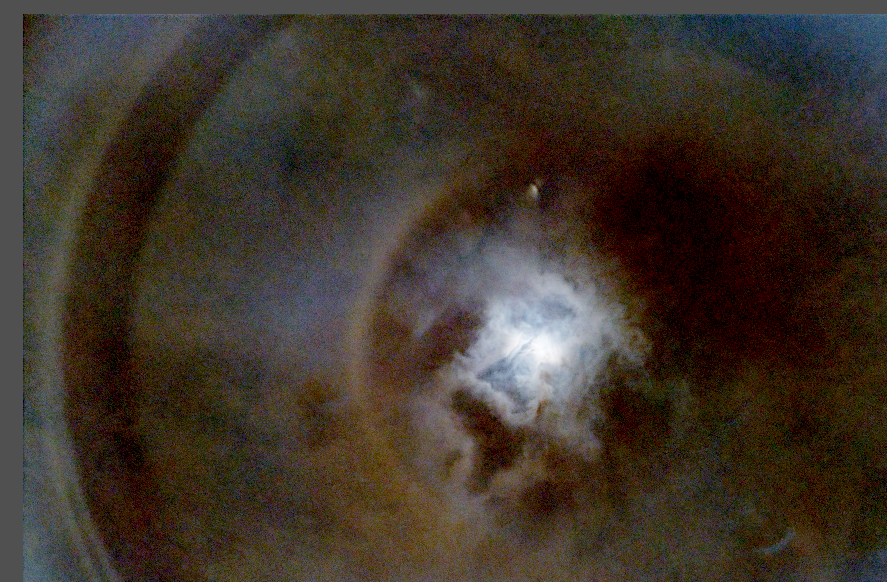This round I had just above 5s exposures and the dew shield, the difference in the single exposures are quite big. The new one is to the right.

I'll post an update after stacking everything.
...
·
 |
|---|
Related, albeit slightly tangiential to the core topic. I had the C8 Dew Heater ring (which I see in your image) and got rid of it. I was finding that if I had it set too high, I got distorted images, presumably because of the uneven heat gradient it created across the corrector. and the air at its surface. This is not your current challenge, but worth a mention given you have the ring and are getting ice instide the tube. After seeing a rather good explanation of what we are trying to achieve with dew heating, I went back to a strap over the dew shield, slightly in front of the corrector. The purpose of applying heat is to keep the air in front of the glass (and thereby the surface of the glass too) slightly warmer than the dew point - heating the glass, as happens with the ring, can be counterproductive if it causes distortions. Of course finer heat control with the Celestron controller might mitigate this problem. Maybe you already have the controler but for those of us who don't, getting it right manually, at least for me, has proven to be less effective than a dew strap. It may also help reduce ice formation inside the tube. Maybe the ring set low, with a strap around the shield might serve as well. Cheers. |
...
·

·
1
like
|
|---|
Everything mentioned in this thread was done by me. Replaced focusers, replaced filter wheels, on and on, everything. Over a period of several months worked with people at pixinsight and other forums. All the above was addressed. Finally, and got confirmation by Roland Christian, that it is reflections. So unless you can resolve this, forget the rest. All of what is being said here has been said countless times before. The celestrons with reducers are at best APC sized. Otherwise reflections kill the image. |
...
·

·
1
like
|
|---|
Paul Larkin: The issue with the dew shield is that it is non-metal, so I don't think it would conduct heat very well if at all with a dew strap. The dew ring works just fine, I've only used it to about 40% capacity as I have insulated my tube and installed fans in the rear. No issues with blooming or weird stars at all. Everything mentioned in this thread was done by me. Replaced focusers, replaced filter wheels, on and on, everything. The last stack didn't go too well either. So I concur, there must be reflections coming off of somewhere in the tube. I am using APS-C. I've grossly overdone this just to highlight how bad it is:  There is very little correction going on at all, even with new flats, maybe the increased contrast in the flats even made things slightly worse. That being said - this is two sets of data so there is some shift from one day to the next as it was being phsyically moved. I didn't expect to see a full correction, but if adding the dew shield was the solution it should have shown a more encouraging result at least. |
...
·
 |
|---|
There is no way that adding the dew shield makes any difference, like never bloody ever. Your inlet pupil is past that, so it shan't be bothered. Try moving the OAG off and see if it improves.
|
...
·
 |
|---|
Moving it or removing it will do nothing. Been there done that. On astronomy tools there is a tool that you can use to determine the distance from the sensor that dust mites and reflections show up. Maybe that can help? I did this and found the reducer was where all the reflections were coming from. So for me, I have decided to do only narrow band. No issues there. |
...
·
 |
|---|
I'm going out on a limb here - Do you have the reducer specific to the EDGE and not the non-EDGE models? Not sure whether that would be an issue or not. I've had my reducer/OAG/EFW setup for 7 years with no issues. This is quite baffling! Hope a solution can be found. |
...
·

·
1
like
|
|---|
Yep - that's the one designed for EDGE SCTs and the one I have. You're got a challenging problem on your hands and I hope you are able to solve it with your own testing and ideas from the Astrobin community. If I think of anything else, I'll let you know. Best of Luck! |
...
·
 |
|---|
Yep - that's the one designed for EDGE SCTs and the one I have. Thank you, I appreciate it! I'll update once I get any further. Real life testing will probably take a while but at least I'll have some time to inspect it while waiting. |
...
·

·
1
like
|
|---|
If there's any comparison testing that would help Jan, let me know. My setup: EDGE HD 8 (Hyperstar) EDGE HD 8 w/ f/7 + Celestron OAG (ZWO ASI174mm mini)+ ZWO EFW + Touptek IMX571M (same chip as ZWO 2600M) Flats using a Spike-a-Flat Fielder Remote operation using NINA and Microsoft Remote Desktop David |
...
·
 |
|---|
If there's any comparison testing that would help Jan, let me know. Thanks, will do! At the moment I am suspecting the reducer to be the culprit but I'm not going to have a chance to try without it until February perhaps. I've still not brought it in to do a reflection test as there is so much moisture outside right now. |